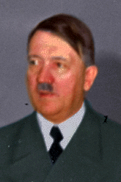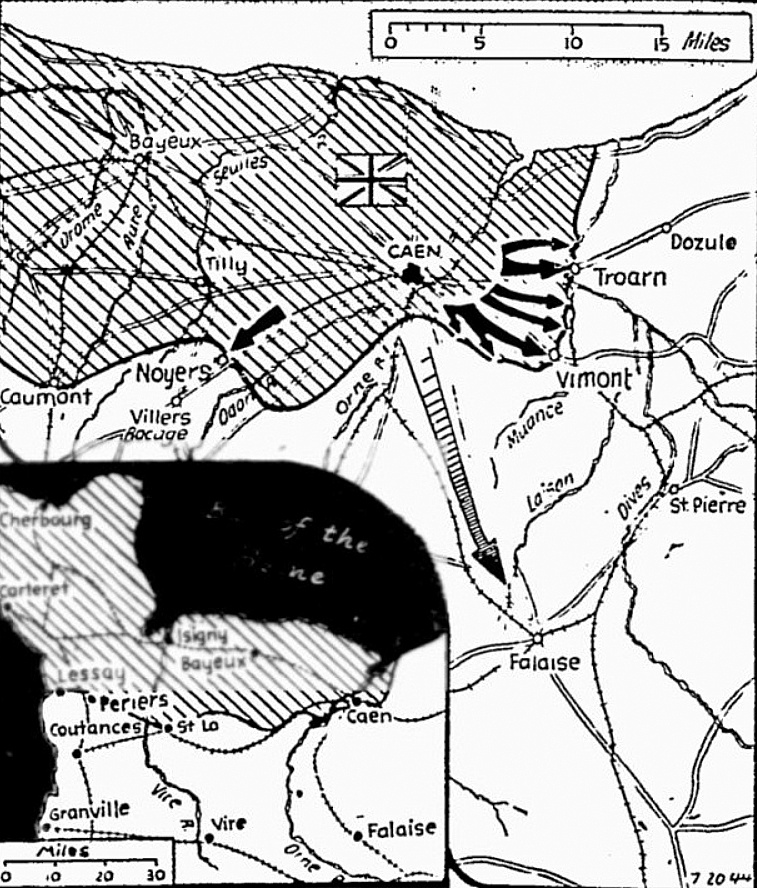The Pittsburgh Press (July 20, 1944)
Hitler, 13 aides injured by assassination bomb
Adolf burned, bruised in headquarters blast; believed ‘inside job’

Adolf Hitler, escapes assassin’s blast
Bulletin
London, England –
A German broadcast at 7:00 p.m. CET repeated the announcement of the attempt on Adolf Hitler’s life and followed through with martial music in place of a previously scheduled discourse on “The Extermination of Rats.”
London, England (UP) –
The official German news agency DNB announced that Adolf Hitler and 13 of his top military and naval collaborators were injured today in an attempt on the Führer’s life when a bomb exploded during a conference at the Führer’s headquarters.
DNB listed Hitler’s injuries as slight burns, bruises and a light concussion of the brain.
The weight of the blast fell upon a cluster of gold-braided Nazis around him. They included seven generals and two admirals. Three were seriously wounded and 10 others, among them Gen. Alfred Jodl, chief of Hitler’s personal military staff and an ardent Nazi, escaped with minor injuries.
Radio Berlin subsequently charged the Allies with the attempt on Hitler’s life, asserting:
Fate protected the Führer’s life from an attempt by the enemy, who has so often worked with murderous methods and who once again tried to achieve with murder what he couldn’t achieve by fair methods.
Benito Mussolini, “Premier” of the Republican Fascist state in northern Italy, appeared to have escaped the bombing by a few minutes.
DNB said Hitler was about to confer with Mussolini when the explosion occurred and that after the debris had been cleared and the wounded cared for, the Führer “resumed his work and conferred with Mussolini as intended.”
Göring, Goebbels nearby
The Nazi propagandists also recorded that Reichsmarschall Hermann Göring – whom Hitler had picked at the outset of the war as the heir to his leadership – arrived shortly after the explosion and conferred with Hitler. Propaganda Minister Joseph Goebbels also arrived afterwards.
One of the four seriously injured was Lt. Gen. Schmundt, chief adjutant of the German Army since 1938 and described by the German Transocean News Agency as “belonging to the closest following of Hitler.”
The DNB dispatch indicated that the blast in Hitler’s headquarters – one of the most closely guarded places in the world – was intended to include Mussolini among the victims, as well as Hitler and his top commanders.
Officers clustered around Hitler apparently received the full strength of the blast, shielding Hitler himself. The Führer’s wounds were described as slight. Those listed as seriously injured were: Lt. Gen. Schmundt, Col. Brandt, Lt. Col. Borgmann, and Borgmann’s aide Berger.
The following were listed as receiving minor injuries: Gen. Alfred Jodl (chief of Hitler’s personal staff), Maj. Gen. Günther Korten (Chief of Staff of the Luftwaffe), Gen. Buhle, Gen. Karl Bodenschatz (liaison officer between Hitler and the Air Marshal’s office), Gen. Heusinger, Gen. Scherff, Adm. von Puttkamer, Adm. Voss.
Details not given
DNB did not specify whether the explosion was caused by a bomb planted inside the room in which Hitler and his commanders were conferring or whether the explosion might have been from a bomb launched from an Allied plane and pinpointed as in recent attacks on German headquarters in Holland and France. The second possibility was regarded as unlikely.
The fact that the attempt evidently occurred inside Hitler’s personal headquarters – as difficult to penetrate as the White House or No. 10 Downing Street – raised speculation in London that it might have been an “inside job” by Germans disgruntled with the conduct of the war and hopeful for a negotiated peace if the leader of Nazism were removed.
This is the first assassination attempt, so far as is known, in which Hitler was injured. The only previous publicized attempt was Nov. 8, 1939, when a bomb exploded in a Munich beer hall shortly after the Führer appeared at a Nazi Party meeting there. This was regarded at the time as a Gestapo trick to strengthen the German home front.
It was considered possible that Hitler’s injuries were more serious than was broadcast to the world by DNB and that the agency’s careful statement that the Führer resumed his work and received Mussolini and Göring was a coverup.
Observers believed the attempt on Hitler’s life was in some way connected with a 14-hour interruption of communications between Germany and neutral countries yesterday and today.
Blast probably yesterday
Although DNB said the explosion occurred “today,” it was considered possible that it occurred yesterday and that communications with Sweden and Switzerland were cut to permit the German propagandists to get their stories in order.
London observers believed there was at least an outside chance that the explosion was the work of the European underground, which has been growing increasingly bold and adept at sabotage and killing. Some analysts also expressed interest in a possible connection with the recent reported estrangement between the conservative Prussian generals and the Nazi hierarchy.
Recalling “the Reichstag fire” plant which enabled the Nazis to seize power by blaming the Communists, they believed some Nazi, possibly Gestapo chief Heinrich Himmler, might have concocted this as a plot which could be blamed on the anti-Nazi generals, who now recognize that the war is lost.
Lean to ‘inside job’
Most authorities familiar with the Nazis leaned to the theory that it was an “inside job.”
Allied psychological warfare experts were surprised only that the attempt had not occurred earlier. They said that all the conditions prerequisite for some such drastic occurrence in Germany had long been bubbling beneath the surface. The sequence included the dismissal of the old and trusted Field Marshal Karl Gerd von Rundstedt from command of the defenses in France, the sacrifice of more than 500,000 men in an effort to hold untenable positions in Russia, failure to write off the Baltic States which now imperil defense of the Reich itself, the growing army of discontented slave labor which is frightening the German home front, and inability to halt or even ameliorate the Allied bombings.
Hitler once escaped by only 11 minutes
By the United Press
Adolf Hitler escaped assassination Nov. 8, 1939, when a bomb exploded in the historic Bürgerbräu Hall in Munich only 11 minutes after the German dictator had left the building. The explosion killed eight persons and injured more than 60.
The hall was ringing with the cheers of Hitler’s 500 “Old Veterans” celebrating the anniversary of their unsuccessful “March on Berlin” with the Führer in 1923, when an explosion from an attic room showered the ceiling upon the Nazis below.
Goebbels blamed British
Propaganda Minister Joseph Goebbels blamed the British for “an obvious attempt on Hitler’s life,” and by Nov. 22, the Gestapo had arrested two British agents: Sigismund Payne Best, 54, and Capt. Richard Henry Stevens, 46.
The agents were kidnapped from Venlo, Holland, where they had gone to investigate a fake German peace proposal. British authorities believed that Best and Stevens were later killed by the Gestapo.
Georg Elser, 36, a mild-mannered Munich workman, was charged with placing the bomb in the attic and allegedly confessed, linking Otto Strasser, leader of the “Black Front” in Paris, with the plan. Elser, it was said, intended that the bomb explode while Hitler was speaking.
Many rumored attempts
There have been other rumored attempts on Hitler’s life but not verified by Nazi sources. They included:
A plot to kill Hitler while he was touring the Polish battlefront in 1939; a foiled shooting at the Kroll Opera House in the same year; a shooting in Vienna in 1938 in which a Stormtrooper was killed by mistake, and another in which Hitler’s chauffeur was reported killed when he exchanged places with the dictator.
Many persons were arrested in Copenhagen in March 1935, when a widespread plot to assassinate Hitler and other Nazi leaders was reported uncovered; and Jan. 10, Ernst Niekisch, a German writer, was sentenced to life imprisonment for plotting with 20 others in another attempt to kill Hitler.



